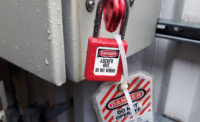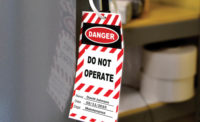It happens fast. Running a machine that removes bran from rice, the operator reached into the exhaust side to remove a buildup of bran. The machine was not locked out. The operator made contact with a fan blade and cut off her fingertip. An employee manually loaded two pallets in the magazine of an automatic palletizer. One pallet jammed. The worker took off the top of the machine and reached inside to push the pallet manually. The machine’s sensor detected that the pallet had cleared, and the dispensing lift plate cycled. The moving parts crushed the worker’s forearm
When LOTO applies
OSHA’s lockout/tagout (LOTO) standard (§1910.147) applies to the control of energy supplies during servicing and/or maintenance of machines and equipment. Activities such as constructing, installing, setting up, adjusting, inspecting, modifying, lubricating, cleaning, unjamming, and making adjustments or tool changes to machines are covered. These tasks can expose the worker to serious hazards if the equipment unexpectedly starts up or otherwise releases hazardous energy. Violations of the LOTO standard ranked fifth on OSHA’s list of the top 10 most frequently cited standards for fiscal year 2015.
During normal production operations, these servicing and maintenance activities are covered by the LOTO standard only if:
- An employee is required to remove or bypass a guard or other safety device; or
- An employee is required to place any part of his or her body into an area on a machine or piece of equipment where work is actually performed upon the material being processed (point of operation) or where an associated danger zone exists during a machine operating cycle.
In the above examples, each operator reached into a danger zone for what was to be a quick fix. OSHA’s LOTO standard notes; “Exception to paragraph (a)(2)(ii): Minor tool changes and adjustments, and other minor servicing activities, which take place during normal production operations, are not covered by this standard if they are routine, repetitive, and integral to the use of the equipment for production, provided that the work is performed using alternative measures which provide effective protection (See Subpart O of this Part [OSHA’s machine safeguarding rules]).”
Minor servicing risks
Without carefully considering risks on a case-by-case basis, using the “minor servicing exception” can lead to serious or fatal injuries. In the first example, the operator could have avoided the need to lock out the machine (and the injury) if she had used a tool to clear the bran build-up. In the second example, the machine was partially disassembled and it’s unlikely that using a long-handled tool to move the pallet would have been effective; applying LOTO is really the only choice to prevent this injury.
The machine operator first notices a problem with equipment, and it’s human nature to look for a quick fix. Unfortunately, once the machine operator identifies what needs to be done, too often he or she underestimates the risks. A mentality of, “This isn’t important enough to call for a mechanic. I can deal with it,” has hurt a lot of people.
Train machine operators
Thorough training eliminates the impulse to take action without proper precautions. Use examples and case studies to point out how simply trying to keep production going can lead to a life-changing injury. Talk with each operator to identify each machine’s tendencies to jam, go out of adjustment, or otherwise malfunction. Have the operators and mechanics brainstorm methods to prevent these occurrences. If the problems can’t be eliminated, provide the operators with the necessary tools to do minor servicing safely. These tools can include LOTO equipment if you want to train the operators as authorized employees so they can clear jams, etc. without risking injuries. Otherwise, make it absolutely clear that operators must stop the machine and call for maintenance.
Provide thorough procedures
Having detailed LOTO procedures for each machine makes it easier to lock out the equipment quickly and correctly. You can have procedures for clearing jams, cleaning, or making minor adjustments in addition to the procedures for replacing belts, gears, or other in-depth repairs. It’s a good practice to post the procedures at the machine.
Inspect and review
OSHA’s standard includes a requirement to periodically inspect LOTO procedures. Affected employees, such as the machine operator, must be included in the review of the procedure only if tagout is used instead of lockout. Still, giving operators an annual reminder of their LOTO-related responsibilities is a good way to raise awareness of the importance of LOTO.



